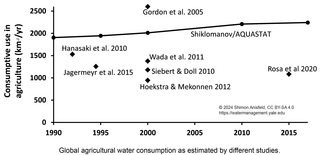Citations
Gordon, L. J., W. Steffen, B. F. Jonsson, C. Folke, M. Falkenmark, and A. Johannessen (2005). “Human modification of global water vapor flows from the land surface.” Proceedings of the National Academy of Sciences of the United States of America 102(21): 7612-7617.DOI: 10.1073/pnas.0500208102.
Hanasaki, N., T. Inuzuka, S. Kanae, and T. Oki (2010). “An estimation of global virtual water flow and sources of water withdrawal for major crops and livestock products using a global hydrological model.” Journal of Hydrology 384(3-4): 232-244.DOI: 10.1016/j.jhydrol.2009.09.028.
Hoekstra, A. Y., and M. M. Mekonnen (2012). “The water footprint of humanity.” Proceedings of the National Academy of Sciences of the United States of America 109(9): 3232-3237.DOI: 10.1073/pnas.1109936109.
Jagermeyr, J., D. Gerten, J. Heinke, S. Schaphoff, M. Kummu, and W. Lucht (2015). “Water savings potentials of irrigation systems: global simulation of processes and linkages.” Hydrology and Earth System Sciences 19(7): 3073-3091.DOI: 10.5194/hess-19-3073-2015.
Rosa, L., D. D. Chiarelli, M. C. Rulli, J. Dell’Angelo, and P. D’Odorico (2020). “Global agricultural economic water scarcity.” Science Advances 6(18): 10.DOI: 10.1126/sciadv.aaz6031.
Siebert, S., and P. Döll (2010). “Quantifying blue and green virtual water contents in global crop production as well as potential production losses without irrigation.” Journal of Hydrology 384(3-4): 198-217.DOI: 10.1016/j.jhydrol.2009.07.031.
Wada, Y., L. P. H. van Beek, and M. F. P. Bierkens (2011). “Modelling global water stress of the recent past: on the relative importance of trends in water demand and climate variability.” Hydrol. Earth Syst. Sci. 15(12): 3785-3808.DOI: 10.5194/hess-15-3785-2011.
